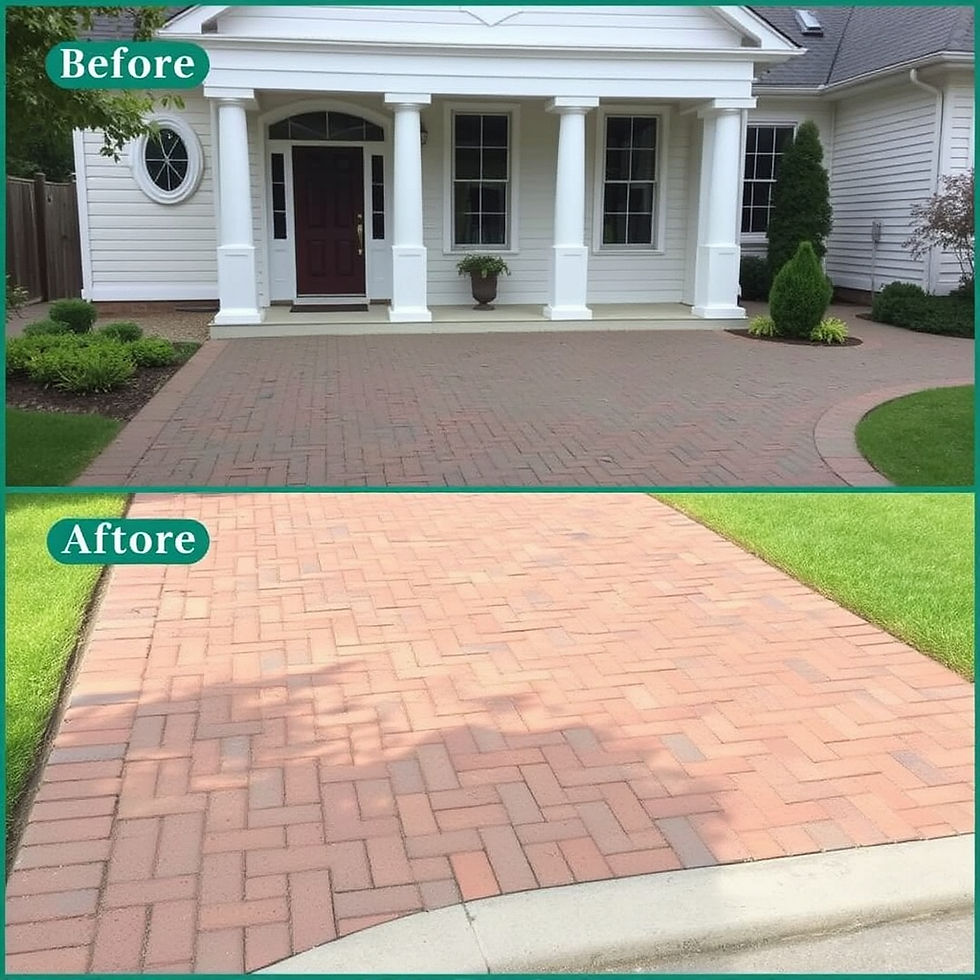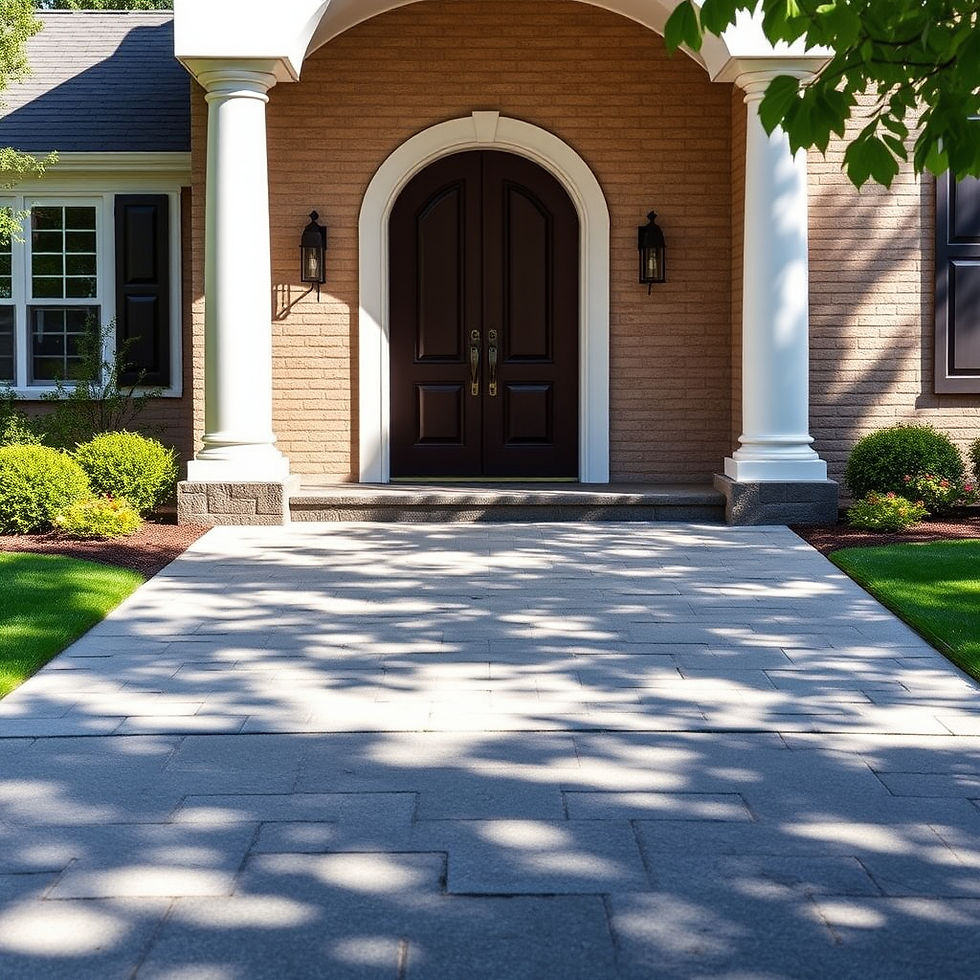Transforming Your Outdoor Space: Installing Paver Walkways and Patios
- Staff Desk
- 2 days ago
- 6 min read

If you're looking to enhance your home's exterior, one of the most effective and rewarding ways to do so is by installing a paver walkway and patio. These additions not only increase the aesthetic appeal of your home but can also significantly boost its value. In this blog, we’ll walk you through a detailed process for installing paver walkways and patios, based on a recent project we worked on.
Step 1: Planning and Preparing the Site
The first step in any paver project is to plan and mark out the space. Let's take an example. We started with a 3-foot-wide walkway that would eventually wrap around the house, as well as a 4-foot-wide stone bed designed for plants. This setup would total around 1,000 square feet.
Marking the Area
We began by marking the areas where we wanted the pavers to go. We used orange paint at first, but when we ran out, we switched to white paint. This was essential for clearly outlining the paths and areas where we would place the pavers. The walkway would extend around the house and lead to a large paver patio. Additionally, we mapped out a circular area for a fire pit, which would serve as the centerpiece of the outdoor space.
Excavation and Base Preparation
Once the area was marked, we began the excavation process. The goal was to dig down to create enough space for the base layer that would hold the pavers. We dug down about 4 inches at first to remove any grass and debris, ensuring that the foundation would be solid.
Since the patio area needed to be built up quite a bit, we planned to add an additional 4 inches of base material. This ensured that the patio area would have a gentle slope for proper drainage.
Step 2: Adding the Base Layer
Laying Down the Base
With the excavation complete, we began adding the base layer. We used stone as the primary base material, and we received a large delivery to fill the area. Our goal was to build up the area enough so that the pavers would sit level and provide a solid foundation. For this project, we used two loads of stone, which we spread out to create a stable surface.
Compaction
After the stone was in place, we compacted the base material. This is a critical step to ensure that the foundation is firm and won’t shift over time. For this task, we used a compactor to press the stone tightly together, creating a smooth and stable surface. The compaction process is essential to prevent any future settling that could affect the pavers' alignment.
Grading for Slope
Once the base was compacted, we checked the slope to ensure proper drainage. The last thing you want is water pooling on your patio or walkway. We aimed for about a 3-inch slope over 12 feet, which would help direct water away from the patio area. It’s important that the slope doesn’t cause water to flow toward the house, so this step is crucial.
Step 3: Laying the Pavers
Preparation and Screeding
Next, we prepared the area for the pavers by laying down a layer of sand. This would act as a bedding layer to help the pavers settle into place. Traditionally, two pipes are used to screed the sand, but we were working with a limited amount of daylight, so we used a quicker method. We set up more pipes and had our team rake the sand into place.
The goal of screeding is to create a level surface with just the right amount of sand, so that the pavers will sit evenly. By adjusting the pipes, we ensured that the sand was level and pitched in the right direction. This step ensures that the pavers won’t shift or become uneven after installation.
Laying the Pavers
Once the sand was ready, we began laying the pavers. We used TECO block pavers for this project, specifically the Eva and Shell Gry colors. These pavers were ideal for the look we were going for, and they’re also durable enough to withstand weather changes.
Laying pavers is a straightforward process, but it requires attention to detail. We started at one corner and worked our way across the space, making sure each paver was aligned correctly. We also left space for expansion, which is important for allowing the pavers to shift slightly without causing damage.
Using a Level to Ensure Even Placement
Throughout the process, we frequently checked the alignment of the pavers using a level. This ensures that the surface stays even and flat as we go. Any slight adjustments made during this step are important for the overall appearance and durability of the paver surface.
Step 4: Installing the Edging
Securing the Edges
To secure the pavers and prevent them from shifting over time, we installed paver edging along the edges of the patio and walkway. This is an important step, as it holds the pavers in place and prevents any shifting that could cause uneven surfaces.
For the curved areas, we used universal edging, which is flexible enough to be molded into any shape. To form the curves, we simply made slits in the edging, which allowed us to bend it around the fire pit area and other curved sections of the patio.
Cutting the Edging
In some places, we needed to cut the edging to fit, especially around tight curves. This was done using a saw to ensure the pieces fit perfectly. It’s important to measure and cut the edging accurately to maintain a clean look.
Step 5: Final Touches
Filling the Gaps
Once the pavers and edging were in place, there were still a few things left to do. We needed to fill the gaps between the pavers to ensure that they stay in place and prevent weeds from growing through. We used polymeric sand for this step. The sand settles between the pavers and hardens when wet, providing a stable surface.
Compacting the Pavers
After the sand was spread, we used a compactor once more to ensure that the pavers were firmly in place. This final compaction helped the sand settle and lock the pavers together, preventing them from shifting over time.
Seeding and Mulching
After all the pavers were in place, we moved on to the landscaping. We used leftover topsoil to fill in the areas around the patio and walkway. Once everything was level, we seeded the soil and covered it with straw to encourage grass growth.
Step 6: The Finished Product
After completing the paver installation and landscaping, the transformation was complete. The walkway now wraps around the house, leading to the spacious paver patio with a fire pit in the center. The landscaping elements, including the rock bed, helped tie the whole design together, creating a functional and visually appealing outdoor space.
Common Mistakes to Avoid
While the paver installation process can be done by DIYers, it’s important to avoid some common mistakes that can affect the quality and longevity of your project:
Not Properly Preparing the Base: A solid base is critical for the stability of your pavers. Make sure the base is compacted properly and that it has the right slope for drainage.
Skipping the Sand Layer: The sand layer helps your pavers settle properly. Don’t skip this step, as it provides a smooth foundation and ensures the pavers remain even.
Improper Edging Installation: Without proper edging, your pavers can shift over time. Make sure you install the edging securely to prevent movement.
Not Allowing for Expansion: Pavers need room to expand and contract with the temperature. Be sure to leave small gaps between the pavers for this purpose.
Conclusion
Installing a paver walkway and patio can significantly enhance your home's curb appeal and provide a beautiful, functional outdoor space. By following these steps carefully, you can achieve a professional-looking result. Whether you’re a DIYer or considering hiring a professional, this guide provides valuable insight into the materials, tools, and techniques you need to complete the job successfully.
FAQs
How do I know how many pavers I need for my project?
Measure the area where you want to lay the pavers and divide it by the size of the pavers you’re using. This will give you an estimate of how many pavers you need.
How deep should I dig for the base layer?
Generally, a depth of 4 inches for the base is recommended. However, if you’re working on a slope or want extra stability, you may need to dig a bit deeper.
Can I install pavers in the winter?
While winter can be challenging, it’s possible to install pavers in colder weather if you take precautions. Ensure that the ground is not frozen and that the weather conditions allow for proper setting of the materials.
How can I prevent weeds from growing between the pavers?
Use polymeric sand between the pavers to fill the gaps. This will harden and help prevent weeds from growing through.
Do I need professional help, or can I do it myself?
Paver installation is a DIY-friendly project, but it requires precision. If you have the time and tools, it’s definitely manageable on your own. If not, hiring a professional can help ensure a flawless result.
By following these steps and tips, you can create a stunning paver walkway and patio that will enhance your home's exterior for years to come.



Comments